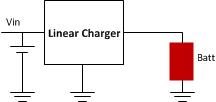Linear chargers and switching chargers are widely adopted in many applications: hearing aids, smart watches, sensor nodes, cellphones, notebooks…you name it! Whenever you use a rechargeable battery, you will need a charger. However, which charger you select may require some more consideration given the pros and cons associated with the different charging topologies available.
Each method has advantages and disadvantages. Linear chargers are small, simple to use and inexpensive. Without any switching, they are great for noise-sensitive applications; but power dissipation is high when the charge current is large. Figure 1 shows the diagram of a linear charger.
Switching chargers are best known for their high efficiency and can minimize power dissipation over wide variations of input adapter voltages. But the additional inductor and capacitors consume more board space, adding BOM cost and design complexity compared to linear chargers. Figure 2 shows a diagram of switching charger. Table 1 compares the features of both charger types.
Figure 1: Linear charger diagram
Figure 2: Switching charger diagram
|
Linear chargers |
Switching chargers |
|
High power dissipation with large charging current |
Higher efficiency and lower power dissipation |
|
Simple design; small solution size |
More complex design |
|
Lower cost |
More components; higher cost |
|
No Electro-magnetic Interference (EMI) concerns |
Switching noise may require more layout consideration |
|
Suitable for charging small batteries or <1.5A charge current |
Suitable for large batteries and fast charging |
Table 1: Feature comparison of linear chargers vs. switching chargers
Which charger you choose will depend on which of the factors in Table 1 are most important for a particular design. Typically, small battery and low-charging current applications such as wearables, Internet of things (IoT) prefer linear chargers due to the small solution size, simple design and lower cost such as thebq25120. Some backup-battery applications such as Emergency Call and GPS location tracker for automotive also prefer a linear charger like bq24081-Q1. Higher-power and multi-cell battery applications such as smartphones, tablets and notebook will use switching chargers, such as the bq24170.
These charger products are customized for supporting different battery chemistries including Li-ion, Li-polymer, LiFePO4, NiMH, Lead-Acid, etc. Due to the high energy density, low maintenance and low self-discharge characteristics, Li-ion batteries are commonly used especially in consumer and industrial applications. LiFePO4 and NiMH are often found in automotive applications due to the stability and reliability nature.
Consider this guide the next time you’ve considered a linear or switching battery charger and optimize your application. Happy designing!
Additional resources:
Read more about the bq25120 in this blog: How to design wearables that are smaller and go longer between charges


